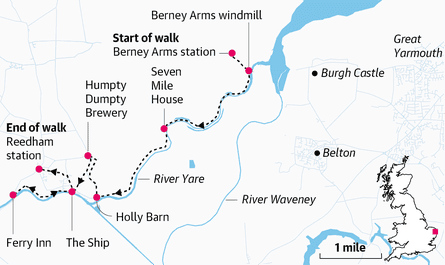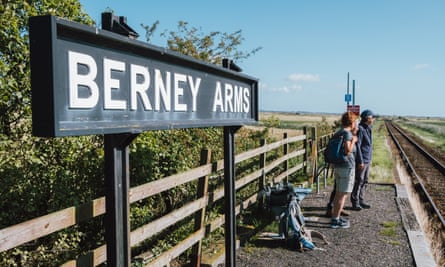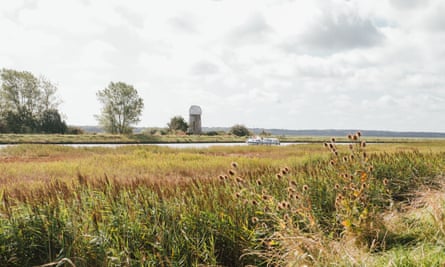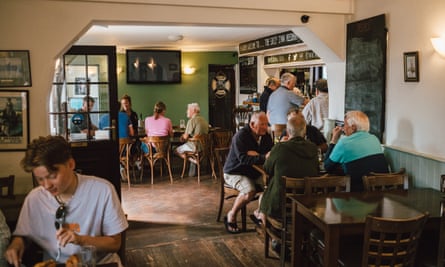Berney Arms is one of England’s most remote railway stations. You can only get to this stretch of the Norfolk Broads by train, boat or a long walk. It’s 25 minutes’ train ride from Norwich, but only two trains stop most days, and I’ve never seen anyone else getting off. Outside the train window, a roe deer steps delicately through green marshes and an egret stands poised by the water. The strange wild beauty is what keeps me coming back. This time I’m arriving with my husband on the 7.36am train from Norwich to walk along the River Yare to Reedham. We head through into the first carriage, the only one that fits next to the tiny station.

There’s an immediate burst of loud, electronic chirruping from a Cetti’s warbler in the reeds as the train pulls away. Heading over soggy meadows towards Norfolk’s tallest drainage mill, we are quickly immersed in a wide, watery landscape. The air is alive with birds: the joyous sliding scales of sedge warblers and noisy peewits from lapwings flapping over the fields. The Broads national park is Britain’s largest protected wetland area and a quarter of the UK’s rarest species live here. Reclaimed from the sea more than four centuries ago, these grazing marshes are now lower than sea level and need protection from the higher tides and longer droughts of a changing climate.
We walk along the riverside embankment with good views in both directions: hares and muntjac deer race across the grass and buntings flit through the reeds. By noon, we’ve seen or heard more than 50 different species of birds. We pass a brown seal lolling on the grassy riverbank, and spot a Norfolk hawker dragonfly, huge and rare, resting among flowers.

Apart from one farmer, waving from his quadbike as he herds smiley Southdown sheep beside the marshes, we don’t see anyone else until we get to Reedham. It’s a day of frothing blossom and cow parsley, gold buttercup carpets and sun-brushed butterflies. But this is a complicated ecosystem, not a simple idyll. Marsh harriers hunt over the reedbeds and kestrels hang in the huge skies.
We detour away from the river towards Reedham church. When the tall, grey stone tower was built, Reedham was a coastal village by an estuary. One of the people who contributed towards building the tower was local heiress Margaret Paston, born in 1422 and married into a wealthy family of Norfolk farmers. The Paston family are famous for their rich archive of medieval letters, chronicling their daily lives and troubles during the Wars of the Roses. Margaret wrote more than a hundred of these letters and describes, among other things, defending the house from armed attack while her husband, John, was in London. In one letter, she asks John for more crossbows and poleaxes and casually adds a request for a pound of sugar, a pound of almonds and some woollen cloth for the kids’ clothes.
Margaret’s mother was part of the Berney family, whose roots run deep in this landscape, giving their name to the station where we started. Berney Arms was also a riverside pub, closed since 2015, and also the name of a nearby windmill, built in 1865. The mill, towering 21 metres (71ft) over the level fields and river, was built to grind clinker for cement; after a couple of decades, it was used to drain the marshes, like most of the other towers we pass with their boat-shaped caps.

Several Berney tombs survive in Reedham church. In one 16th-century tableau, Henry and Alice Berney kneel at prayer with their nine children dutifully ranged behind them in mini-me ruffs and headdresses. Herringbone layers of Roman tiles are embedded in the church walls, recycled from earlier buildings on the site. In 1981, a builder’s cigarette on the thatched church roof led to a catastrophic fire and there are now modern stained-glass windows by Sarah Bristow, with almost-invisible etched maps behind spectral crosses.
Outside the church, faint fairground music jangles over the fields from the Pettitts Adventure Park, featuring meerkats, monkeys, Jurassic golf and rides on bouncing kangaroos. Just beyond it, the Humpty Dumpty microbrewery recently celebrated its 25th birthday. It’s named after the top-heavy steam engines that chuffed between Norwich and Lowestoft a century ago. The brewery shop is piled with jars of local honey and bottles of fruity gin. Sitting outside, I sip a half of malty Reedham Mild and watch a pied wagtail in the afternoon sun.

Ten minutes away in the Ship, they’re serving Humpty Dumpty’s Little Sharpie, gold and lightly hoppy, along with other local real ales. The railway station is a 15-minute stroll from the pub along lanes and paths, with trains back to Norwich. But we detour first another half a mile along the riverbank to ride the Reedham chain ferry over the Yare and back.
Google map of the route
Allow Google content?
This article includes content provided by Google. We ask for your permission before anything is loaded, as they may be using cookies and other technologies. To view this content, click ‘Allow and continue’.
Start Berney Arms railway station
End: Reedham railway station
Distance: 8½ miles
Time: 4½ hours
Total Ascent: 35 metres
Difficulty: Easy
OS map of the route (with GPX)
The pub

Roses and honeysuckle straggle round the door of the Ship, a down-to-earth village pub with a riverside beer garden. It’s next to Reedham’s swing bridge, which carries the railway over the Yare on its way to Lowestoft and Yarmouth. Warm brick walls and bay windows are flanked by fragrant orange wallflowers and hanging baskets of petunias.
Inside, there are black-and-white photos of boats outside the Ship Hotel 50 years ago and old advertisements urging travellers to reach the Norfolk Broads by train (“It’s quicker by rail”). The pub grub includes proper skin-on homemade chips, beer-battered fish and daily specials chalked on a board next to the bar.
On Facebook

Where to stay
We are spending two nights at the Assembly House, a Georgian mansion in the middle of Norwich. It’s a 20-minute stroll or 10-minute bus ride from the railway station and everything about it – from the fairy-lit facade and four-poster beds to the fresh milk and underfloor heating – feels luxurious. Every room is totally distinct. Our palatial space, with views of the courtyards below, is one of four added recently in the west wing; the walls are pale lavender, an antique chandelier and shelves of gold-lustre porcelain. Breakfast includes compote and granola, Norfolk rarebit or buttermilk pancakes. It’s served in a grand hall with wreaths of ornate stuccowork or in the neighbouring dining room with its Bridgerton-esque pink-and-lime-green twist on playful Georgian aesthetics.
Doubles from £170 B&B, assemblyhousenorwich.co.uk
